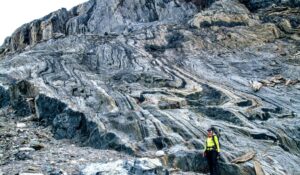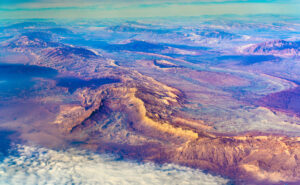We’ve all heard of tsunamis, but what about a fog tsunami? Sometimes, in late spring and early summer, beachgoers get spooked by a giant wave of dense fog hovering over the sea.
A fog tsunami looks intimidating, even dangerous. However, it’s merely a massive fog bank that can form over large bodies of water. It can stretch along a coastline for over 40km and rise hundreds of metres high.
This tidal wave of fog can be so large that it is sometimes visible from space. It may form on sunny, cloudless days, seemingly out of nowhere. The fog takes several minutes to slide into shore and may completely block out the sun. It is often mistaken for a shelf cloud.

A shelf cloud, above, is often mistaken for a fog tsunami. Photo: Jeff Gammons StormVisuals/Shutterstock
What makes a fog tsunami?
Fog is simply a result of evaporation and condensation. It occurs when water vapor condenses, and water droplets remain suspended in the air. These droplets form a cloud, which we know as fog. There are many types of fog: radiation fog, advection fog, ice fog, upslope fog, valley fog, freezing fog, and steam fog.

A fog tsunami develops over Plymouth Sound in England. Photo: Bianca Guguila
A fog tsunami is a type of advection fog. This forms when warm, moist air condenses as it flows horizontally over a much colder watery surface. In late spring and early summer, the land begins to warm as the days grow longer. During this gentle warming progress, bodies of water can still be cold. The water cools the warm air significantly, which condenses to form minuscule water droplets. These droplets eventually turn into a giant wall of fog.
The fog tsunami forms and maintains its distinctive wall shape because of a sea breeze front. This forms when there is a change in air pressure and wind speed, and when hot, unstable air from the land meets cooler, stable air from the sea. These opposing forces create an invisible boundary, allowing the fog to form a wall. This wall then moves slowly toward the land.

A wave-like fog develops in New Jersey, USA. Photo: Sea Girt Lifeguards/Twitter
There is no set temperature at which the fog forms. According to researchers at UC Santa Barbara, as long as the sea temperature is much lower than that of the air, a fog bank can appear.
The fog dissipates when conditions change. For instance, if the wind changes direction, if the sea warms, or if there is less moisture in the air. Otherwise, the fog can persist for hours or even days.
Mistaken for a real tsunami
With the rise of social media, the phenomenon received increased attention. In 2014, a fog tsunami formed on Lake Michigan. A year later, another one alarmed people on the beaches of Sea Girt, New Jersey. They believed that the fog was a real tsunami. This prompted the National Weather Service to issue an official explanation: “This is not a tsunami but a fog bank off the Jersey coast.”
In 2018, a fog tsunami formed off the coast of Cornwall in the UK, attracting a great deal of attention.

Fog tsunami in Cornwall, UK. Photo: Dan Bourne/Magnus News/Daily Mail
While visually stunning, a fog tsunami does come with drawbacks. When the fog travels inland, visibility is significantly reduced. Ships have to remain in port, planes are grounded, and driving becomes hazardous.
You can typically find fog tsunamis along the Pacific Coast of the U.S., England’s south coast, and many other places where conditions can birth this type of fog.






